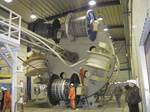Modular Cable Offers Flexibility
The Composite Carbon Cable system developed by Doris Engineering, IFP, Soficar and Freyssinet is based on a different design. Their concept is to assemble a tether from uniformly sized strands or “modules” made up of parallel rods. Each module is hexagonally shaped, allowing any number of modules (strands) to
Share
The Composite Carbon Cable system developed by Doris Engineering, IFP, Soficar and Freyssinet is based on a different design. Their concept is to assemble a tether from uniformly sized strands or “modules” made up of parallel rods. Each module is hexagonally shaped, allowing any number of modules (strands) to be assembled, honeycomb fashion, into a tether of the required diameter. Their current module consists of 19 large-tow PAN carbon fiber rods about 0.25 inch/6 mm in diameter. The rods are pultruded with an epoxy resin supplied by Soficar. Each completed module is wrapped in a polyethylene sheath and individually anchored in a compact steel anchorage or end fitting.
The assembled tether is also sheathed with polyethylene to keep the tether watertight and protect it from mechanical damage. Voids between rods and modules are filled with a lightweight fill material to help the tether withstand hydrostatic pressures at great depths. Because modules have the same fatigue and mechanical properties, the testing of individual strands is statistically representative of the entire tether assembly.
The Freyssinet composite cable was specifically designed for use with TLPs. However, the diameter of the rods, the number of rods in a module, and the number of modules used can be easily tailored to suit specific requirements. Andrieux of Doris Engineering says, “The idea is to extend this system not only to TLP anchorage, but also to tensioned lateral mooring systems such as FPSO or spar platforms.”
In keeping with this intention, the Composite Carbon Cable system was recently used on the cable-stayed Laroin footbridge over the River Gave de Pau in southwest France. The 360 ft/110m span of the bridge is supported by eight pairs of carbon cables. The extremely high strength of the carbon fiber allows the composite tether to withstand the load. The engineering team expects that use of the composite tether will greatly improve the performance of offshore platforms like TLPs in very deep water.
Related Content
-
Plant tour: Airbus, Illescas, Spain
Airbus’ Illescas facility, featuring highly automated composites processes for the A350 lower wing cover and one-piece Section 19 fuselage barrels, works toward production ramp-ups and next-generation aircraft.
-
From the CW Archives: Airbus A400M cargo door
The inaugural CW From the Archives revisits Sara Black’s 2007 story on out-of-autoclave infusion used to fabricate the massive composite upper cargo door for the Airbus A400M military airlifter.
-
Carbon fiber satellite arm reduces weight, simplifies assembly onto naval vessels
Satcom developer EM Solutions partnered with ACS Australia to replace an aluminum arm design with a 65% lighter, one-piece, corrosion-resistant carbon fiber/epoxy alternative.











